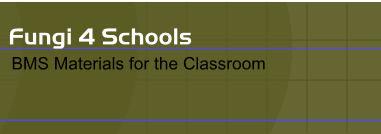|

Teacher’s Guides
to the British
Mycological Society’s materials for the classroom
What you are reading on this page is the first in a set of helpful Guides
which introduce you to the materials available here, provide
academic backup to the topics covered and practical guidance on how
to make best use of these materials (indexed as TG01-TG05).
NOTE that TG05 contains advice about how and where to get more
information and advice about fungi.
TG01: Introduction and overview
Download the PDF
Download the Word.doc
TG02: Fungal cells
Download the PDF
Download the Word.doc
TG03: The World of Fungi
Download the PDF
Download the Word.doc
TG04: What’s Your Favourite Fungus?
Download the PDF
Download the Word.doc
TG05: Discover More
Download the PDF
Download the Word.doc
Additional Resources
We offer guidance towards additional information
in print and on the Internet. Use the links below.
The School
Trip
A guide to the information needed to enjoy a school trip safely.
Download
PDF file or
MSWord.doc.
Key Stages 2
and 3
To access materials aimed at Key Stages 2 and 3
CLICK
HERE.
Post-16
resources
To access materials suggested for post-16 pupils
CLICK HERE.
|

Why fungal biology
matters
This teaching pack has been produced to draw
attention to the lack of fungal biology in the National Curriculum.
We think this is important because questions to year 10 pupils (and
many others) reveal their almost complete ignorance of these
organisms. Ask an average group of year 10s if they think fungi are
bacteria, plants or something different and the vast majority will
choose bacteria and the rest plants. The right answer will be
rarely, if ever, encountered.
Fungi are not bacteria and they're not plants, either
Because fungi are eukaryotes which have the
complex cell structures and abilities to make tissues and organs
that we expect of higher organisms. But fungi are not plants, and
are so different from plants that no amount of plant biology will
give an adequate understanding of any fungus. Similarly, although
more closely related, in molecular terms, to animals than to plants,
fungi are not animals and a deficiency of fungal biology cannot be
compensated by more zoology.
Awareness and understanding of fungi is a
worthwhile educational goal, not least because we depend on fungi
every day of our lives and fungi form what is arguably the largest
kingdom of organisms on the planet. However, it’s probably a more
important consideration that the fact that they are practically
ignored in the National Curriculum means that pupils are not being
introduced to the full range of living things. Teaching biology this
way is like trying to teach reading with only two-thirds of the
alphabet.
Currently very little of either cell or fungal
biology appears in any of the GCSE science specifications. Included
in this package is an article that discusses the deficiencies in the
curriculum specifications in UK primary and secondary schools in
some detail and we will not repeat it here.
CLICK
HERE to see that article.
The bulk of the material in this package is an assortment of learning resources designed for you to
use in your teaching. These
ready-made (and classroom-tested) lessons and workshop sessions
cover a range of fungal topics from cell structure and function,
through biotechnology to health topics and plant growth and disease.
The resources are in a number of accessible formats, so the content
can be adapted to the needs of individual teachers and pupils, and
targeted to different areas of the National Curriculum. They also
include games and activities, aiming to increase knowledge and
awareness of fungi in an active, entertaining, way and thereby
maintain interest in biology as a science.
The British Mycological Society’s
materials for the classroom
The materials provided here have been designed
for pupils in years 8 to 11 of secondary school. Other years are
catered for by other BMS resources. [CLICK HERE to go directly to
Key Stage 2-3 resources;
CLICK HERE to go to materials suggested for post-16 pupils]. We have tried to use a level of
language and presentation that will suit this range of ages and the
class sheets have all been well received in classroom tests.
However, younger pupils may have a little difficulty with the
language, whereas older pupils may need more challenging activities.
Teachers can easily adapt the materials (they are available as
readily-edited word processor and PowerPoint files) to suit the age,
level and capabilities of their own pupils. On the basis of
classroom experience we would say that the ability of younger pupils
to cope with scientific names and scientific phraseology should not
be underestimated. A little help
and encouragement (particularly with pronunciation) soon gets them ‘talking the talk’!
Tried
and Tested
All the materials and activities included in this handbook have been
used in classroom trials with pupils across years 8 to 11. Some of the resources were used as an event during National
Science Week 2005; the five fungal lessons have been trialled with a
year 10 class at an inner city school in Manchester; parts of these
resources have also been included in science workshops for schools
at the Manchester Museum and some of the materials
were used at Summer School events for pupils from Liverpool,
Rochdale and Manchester schools in the ‘Excellence in Cities’
programme. In all of these trials pupil feedback on the materials
was collected; comments were positive and the pupils were interested
and enthusiastic to be learning about a topic many had hardly
touched upon before. Hopefully, this means that the materials are
effective in delivering new information in an interesting way and
you will also experience this positive response as your pupils enjoy
learning about fungi and recognise the relevance of the knowledge to
their everyday lives. |

Here you can
access about 100 pages of classroom-ready resources, in both PDF
format - for easy printing - and Word or PowerPoint format - for easy
modification and adaptation.
Fungal Cells
An integrated set
of brief class sheets dealing with cells and cell biology,
which ensure proper representation of both yeast and
filamentous fungi, but also give a comprehensive summary
of cells in all organisms (indexed as FC01-FC03).
CLICK HERE to go
directly to the Fungal Cells contents page.
World of Fungi
A series of five
ready-made KS4 lessons and classroom activities comprising an
introductory Welcome to the
World of Fungi, Reproduction
and Conservation, Favourite
or Nastiest Fungus, Fungi
and Industry and Fungi and
Disease. All of these lesson packages include a full set of
class sheets for the pupils (indexed as WF01-WF05), and a collection
of question sheets for the students.
CLICK HERE to go
directly to the World of Fungi contents page.
What’s
your Favourite Fungus?
An integrated series of class sheets telling 15 different stories
about fungal biology that provides the basis for a ‘What’s your
favourite fungus?’ set of activities. They can be used in a
variety of ways. We suggest that pupils investigate the stories and
extract important points from them. As supporting resources there is a ‘name-game’ starter exercise, a pack of playing cards
that mirror the class sheets and can be used to play a variety of
games, and some display posters
related to the class sheets (indexed as FF01-FF26).
CLICK HERE to go
directly to the What's Your Favourite Fungus? contents page.
Funky Fungi
workshop
A workshop, training exercise or demonstration for GCSE pupils to
promote awareness and understanding of fungi.
CLICK
HERE to go to the workshop page.
Copy freely for the classroom
All rights reserved for commercial use.
©
British Mycological Society 2005.
The writing team
Written for the British Mycological Society by staff
and students in the Faculty of Life Sciences at the University of
Manchester.
CLICK HERE for details.
|





